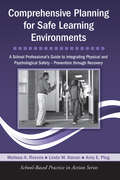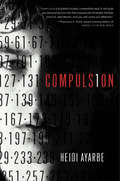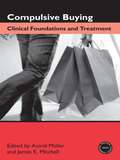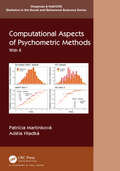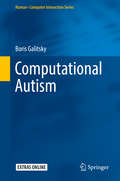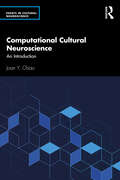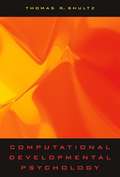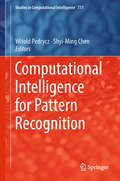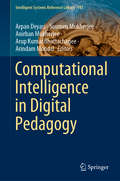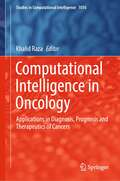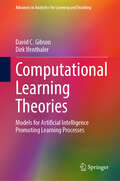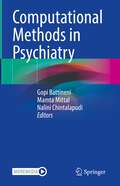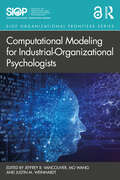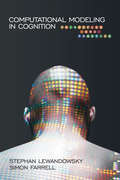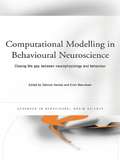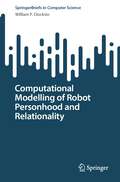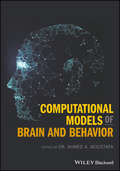- Table View
- List View
Comprehensive Models of Autism Spectrum Disorder Treatment: Points of Divergence and Convergence
by Raymond G. Romanczyk John MceachinThis book presents proceedings from the joint conference, Evidence and Rationales for Comprehensive Models of Autism Spectrum Disorder Treatment: Divergence and Convergence, sponsored by the Council on Autism Services and the Autism Partnership. It addresses the growing need for, and current lack of, effective services for children with autism spectrum disorder (ASD) and compares several key evidence-based interventions. Chapters examine various approaches to ASD treatment, including key concepts, goal development, procedures, and staffing. This unique volume explores fundamental similarities and differences among leading treatment models; discusses the challenges of implementing programs, educating parents, training staff, and funding issues; and speaks to the need for more meaningful collaboration in this multidisciplinary field. Using an integrative perspective, new tools are presented to help readers make informed choices about how to select and advocate for specific treatments and develop individualized interventions for improved outcomes for children with ASD. Featured topics include: The Lovaas Model. The Early Start Denver Model. The New England Center for Children's Autism Curriculum Encyclopedia (ACE®). The value of applied behavior analysis (ABA) as a treatment for autism. Implementation parameters for ASD treatments. Comprehensive Models of Autism Spectrum Disorder Treatment is an essential resource for clinicians, practitioners, applied behavior analysts, therapists, educators, and administrators as well as researchers and graduate students in school, clinical child, and developmental psychology, behavior therapy, special education, social work, child and adolescent psychiatry, rehabilitation medicine/therapy, and pediatrics.
Comprehensive Planning for Safe Learning Environments: A School Professional's Guide to Integrating Physical and Psychological Safety – Prevention through Recovery (School-Based Practice in Action)
by Melissa A. Reeves Linda M. Kanan Amy E. PlogThis book provides school administrators, school-based mental health professionals, and other educational professionals with the framework and tools needed to establish a comprehensive safe learning environment. The authors identify four necessary phases to achieve this (prevention, preparedness, response, and recovery) and provide numerous examples and tools to help readers create safe environments, while also addressing students’ academic, emotional, and social needs. An emphasis is placed on the importance of the balance between physical and psychological safety within a multi-tiered framework - it is not enough for students to know their school is secure; they must also feel they are safe and can turn to their teachers and school-based mental health professionals with their concerns. An accompanying CD contains several valuable resources, such as forms, handouts, articles, and monitoring tools.
Comprehensive Stress Management (Thirteenth Edition)
by Jerrold S. GreenbergComprehensive Stress Management empowers students to learn what stress is, evaluate their level of stress, and apply to their own lives the tools and skills to manage that stress. The book examines a variety of topics relevant to college students such as intrapersonal and interpersonal stressors, physiological reactions to stress, spirituality and stress, occupational stress, and family stress. Lab Assessments at the conclusion of each chapter help students relate what they have learned to their personal lives by encouraging them to identify specific attitudes, behaviors, and coping skills as well as target areas for improvement. The 13th edition incorporates many changes and updates while still retaining the content and features valued by instructors and students over the previous editions.
Comprehensive Women’s Mental Health
by David J. Castle Castle, David J. and Abel, Kathryn M. Kathryn M. AbelThis is a comprehensive, up-to-date and evidence-based review of women's mental health. It starts by considering the social and cultural contexts of women's lives today before addressing how developmental aspects pertain to mental health, exploring biological, evolutionary and psychosocial parameters. The heart of the book contains a series of chapters with a clinical emphasis. These aim to elucidate causal mechanisms for gender differences in mental disorder considering hormonal and environmental influences. The therapeutic implications of gender are then addressed in some detail, with a focus on inter-partner and other forms of violence, substance misuse, personality disorder and post-traumatic stress disorder. The book concludes with a detailed section considering psychosis and its sequelae in women and their families. The book's scope is intended to be broad, and it is aimed at a clinical audience including psychiatrists and general physicians, as well as mental health nurses, psychologists, social workers and occupational therapists.
Compulsion
by Heidi Ayarbe<P>Today has to be perfect. <br>Magic. <br>I look at the clock. <br>10:14 AM. <P>Ten fourteen. One plus one is two plus four is six plus ten is sixteen minus one is fifteen minus two is thirteen. OK. <P>I turn from the clock and walk into the hallway. "Ready." <P>Saturday will be the third state soccer championship in a row for Jake Martin. Three. A good number. Prime. With Jake on the field, Carson City High can't lose because Jake has the magic: a self-created protection generated by his obsession with prime numbers. It's the magic that has every top soccer university recruiting Jake, the magic that keeps his family safe, and the magic that suppresses his anxiety attacks. But the magic is Jake's prison, because sustaining it means his compulsions take over nearly every aspect of his life. <P>Jake's convinced the magic will be permanent after Saturday, the perfect day, when every prime has converged. Once the game is over, he won't have to rely on his sister to concoct excuses for his odd rituals. His dad will stop treating him like he is some freak. Maybe he'll even make a friend other than Luc. <P>But what if the magic doesn't stay? <P>What if the numbers never leave? <P>Acclaimed author Heidi Ayarbe has created an honest and riveting portrait of a teen struggling with obsessive compulsive disorder in this breathtaking and courageous novel.
Compulsive Acts: A Psychiatrist's Tales of Ritual and Obsession
by Elias AboujaoudeIn this book, we meet a man who can't let anyone get within a certain distance of his nose, two kleptomaniacs from very different walks of life, an Internet addict who chooses virtual life over real life, a professor with a dangerous gambling habit, and others with equally debilitating compulsive conditions. Elias Aboujaoude tells stories inspired by memorable patients he has treated, taking us from initial contact through the stages of the doctor-patient relationship.
Compulsive Buying: Clinical Foundations and Treatment (Practical Clinical Guidebooks)
by James E. Mitchell Astrid MüllerRooted in research and clinical practice, Compulsive Buying examines the drive that compels people to compulsively purchase and hoard their acquisitions. The authors and contributors cover the entire scope of this behavior and discuss what clinicians need to know in order to better understand and treat their clients. Among the key subjects examined are case reports, correct diagnosis, assessment and instruments, comorbidity, treatment, research, and directions for future research. The book ends with a useful guide for therapists, which includes data and research; and a treatment manual, which includes questionnaires and exercises for clinician and client alike.
Compulsive Exercise And The Eating Disorders: Toward An Integrated Theory Of Activity
by Alayne YatesThe author examines the linkages and similarities between compulsive athletics and eating disorders, and proposes that they are different manifestations of a single condition: the activity disorder.
Compulsive Sexual Behaviours: A Psycho-Sexual Treatment Guide for Clinicians
by Silva NevesCompulsive Sexual Behaviours offers a unique approach to the struggles people face with their out-of-control sexual behaviours. This comprehensive guide is deeply rooted in the science of sexology and psychotherapy, demonstrating why it is time to re-think the reductive concept of ‘sex addiction’ and move towards a more modern age of evidence-based, pluralistic and sex-positive psychotherapy. It is an important manual for ethical, safe and efficient treatment within a humanistic and relational philosophy. This book will be an important guide in helping clients stop their compulsive sexual behaviours as well as for therapists to self-reflect on their own morals and ethics so that they can be prepared to explore their clients’ erotic mind.
Computational Aspects of Psychometric Methods: With R (Chapman & Hall/CRC Statistics in the Social and Behavioral Sciences)
by Patricia Martinková Adéla HladkáThis book covers the computational aspects of psychometric methods involved in developing measurement instruments and analyzing measurement data in social sciences. It covers the main topics of psychometrics such as validity, reliability, item analysis, item response theory models, and computerized adaptive testing. The computational aspects comprise the statistical theory and models, comparison of estimation methods and algorithms, as well as an implementation with practical data examples in R and also in an interactive ShinyItemAnalysis application. Key Features: Statistical models and estimation methods involved in psychometric research Includes reproducible R code and examples with real datasets Interactive implementation in ShinyItemAnalysis application The book is targeted toward a wide range of researchers in the field of educational, psychological, and health-related measurements. It is also intended for those developing measurement instruments and for those collecting and analyzing data from behavioral measurements, who are searching for a deeper understanding of underlying models and further development of their analytical skills.
Computational Autism (Human–Computer Interaction Series)
by Boris GalitskyThis book explores and evaluates accounts and models of autistic reasoning and cognition from a computational standpoint. The author investigates the limitations and peculiarities of autistic reasoning and sets out a remediation strategy to be used by a wide range of psychologists and rehabilitation personnel and will also be appreciated by computer scientists who are interested in the practical implementation of reasoning. The author subjects the Theory of Mind (ToM) model to a formal analysis to investigate the limitations of autistic reasoning and proposes a formal model regarding mental attitudes and proposes a method to help those with autism navigate everyday living. Based on the concept of playing with computer based mental simulators, the NL_MAMS, is examined to see whether it is capable of modeling mental and emotional states of the real world to aid the emotional development of autistic children. Multiple autistic theories and strategies are also examined for possible computational cross-overs, providing researchers with a wide range of examples, tools and detailed case studies to work from. Computational Autism will be an essential read to behavioral specialists, researcher's, developers and designers who are interested in understanding and tackling the increasing prevalence of autism within modern society today.
Computational Cultural Neuroscience: An Introduction (Essays in Cultural Neuroscience)
by Joan Y. ChiaoThis book provides novel insights into the study of empirical computational approaches in the field of cultural neuroscience. It discusses and analyses topics such as cultural intelligence, cultural machine learning, cultural brain dynamics and cultural security. This comprehensive text engages with computational principles to guide the research on the influence of cultural environments on human genetics. It explores the theoretical and methodological approaches involved in computational neuroscience. The author elucidates how cultural processes intersect with the structural organization of the nervous system, contributing to the study of computational principles and neural information-processing mechanisms at the cultural level. Research in this subject area can help provide better understanding of the role of computation in cultural neuroscience, stimulating further research into practice and policy.Computational Cultural Neuroscience: An Introduction is the ideal resource for academics, researchers and students of psychology, neuroscience, computer science or philosophy, who are interested in cultural neuroscience.
Computational Developmental Psychology
by Thomas R. ShultzAn overview of the emerging discipline of computational developmental psychology, emphasizing the use of constructivist neural networks.
Computational Intelligence for Pattern Recognition (Studies In Computational Intelligence #777)
by Witold Pedrycz Shyi-Ming ChenThe book presents a comprehensive and up-to-date review of fuzzy pattern recognition. It carefully discusses a range of methodological and algorithmic issues, as well as implementations and case studies, and identifies the best design practices, assesses business models and practices of pattern recognition in real-world applications in industry, health care, administration, and business. Since the inception of fuzzy sets, fuzzy pattern recognition with its methodology, algorithms, and applications, has offered new insights into the principles and practice of pattern classification. Computational intelligence (CI) establishes a comprehensive framework aimed at fostering the paradigm of pattern recognition. The collection of contributions included in this book offers a representative overview of the advances in the area, with timely, in-depth and comprehensive material on the conceptually appealing and practically sound methodology and practices of CI-based pattern recognition.
Computational Intelligence in Digital Pedagogy (Intelligent Systems Reference Library #197)
by Anirban Mukherjee Arpan Deyasi Soumen Mukherjee Arup Kumar Bhattacharjee Arindam MondalThis book is a useful guide for the teaching fraternity, administrators and education technology professionals to make good use of AI across outcome-based technical education (OBTE) ecosystem and infuse innovations and affordable digital technologies to traditional pedagogic processes to make teaching-learning more independent of human factor (teacher/student quality), time and place and at the same time more impactful and enjoyable for the learners. Providing access to the digital media and learning tools (even to the extent of mobile apps) to the students would allow them to keep pace with innovations in learning technologies, learn according to their own pace and improve their understanding level and have instantaneous feedback and evaluation. The book explores these new challenges and scope of using computational intelligence in educational technology. The book also addresses how based on the data collected from the outcome of conventional educational system, intelligent diagnostic and feedback system is developed which will change the teaching strategies and corresponding teaching-learning process. The book covers a wider framework of digital pedagogy and its intelligent applications on various sectors of education system.
Computational Intelligence in Oncology: Applications in Diagnosis, Prognosis and Therapeutics of Cancers (Studies in Computational Intelligence #1016)
by Khalid RazaThis book encapsulates recent applications of CI methods in the field of computational oncology, especially cancer diagnosis, prognosis, and its optimized therapeutics. The cancer has been known as a heterogeneous disease categorized in several different subtypes. According to WHO’s recent report, cancer is a leading cause of death worldwide, accounting for over 10 million deaths in the year 2020. Therefore, its early diagnosis, prognosis, and classification to a subtype have become necessary as it facilitates the subsequent clinical management and therapeutics plan. Computational intelligence (CI) methods, including artificial neural networks (ANNs), fuzzy logic, evolutionary computations, various machine learning and deep learning, and nature-inspired algorithms, have been widely utilized in various aspects of oncology research, viz. diagnosis, prognosis, therapeutics, and optimized clinical management. Appreciable progress has been made toward the understanding the hallmarks of cancer development, progression, and its effective therapeutics. However, notwithstanding the extrinsic and intrinsic factors which lead to drastic increment in incidence cases, the detection, diagnosis, prognosis, and therapeutics remain an apex challenge for the medical fraternity. With the advent in CI-based approaches, including nature-inspired techniques, and availability of clinical data from various high-throughput experiments, medical consultants, researchers, and oncologists have seen a hope to devise and employ CI in various aspects of oncology. The main aim of the book is to occupy state-of-the-art applications of CI methods which have been derived from core computer sciences to back medical oncology. This edited book covers artificial neural networks, fuzzy logic and fuzzy inference systems, evolutionary algorithms, various nature-inspired algorithms, and hybrid intelligent systems which are widely appreciated for the diagnosis, prognosis, and optimization of therapeutics of various cancers. Besides, this book also covers multi-omics exploration, gene expression analysis, gene signature identification of cancers, genomic characterization of tumors, anti-cancer drug design and discovery, drug response prediction by means of CI, and applications of IoT, IoMT, and blockchain technology in cancer research.
Computational Learning Theories: Models for Artificial Intelligence Promoting Learning Processes (Advances in Analytics for Learning and Teaching)
by Dirk Ifenthaler David C. GibsonThis book shows how artificial intelligence grounded in learning theories can promote individual learning, team productivity and multidisciplinary knowledge-building. It advances the learning sciences by integrating learning theory with computational biology and complexity, offering an updated mechanism of learning, which integrates previous theories, provides a basis for scaling from individuals to societies, and unifies models of psychology, sociology and cultural studies. The book provides a road map for the development of AI that addresses the central problems of learning theory in the age of artificial intelligence including: optimizing human-machine collaborationpromoting individual learningbalancing personalization with privacydealing with biases and promoting fairnessexplaining decisions and recommendations to build trust and accountabilitycontinuously balancing and adapting to individual, team and organizational goalsgenerating and generalizing knowledge across fields and domainsThe book will be of interest to educational professionals, researchers, and developers of educational technology that utilize artificial intelligence.
Computational Methods in Psychiatry
by Mamta Mittal Gopi Battineni Nalini ChintalapudiThis book presents a particular area of interest in computing psychiatry with the modelling of mood and anxiety disorders. It highlights various methods for building these models. Clinical applications are prevalent due to the growth and interaction of these multiple approaches. Besides, it outlines some original predictive and computational modelling ideas for enhancing psychological treatment interventions. Computational psychiatry combines multiple levels and types of computation with different data types to improve mental illness understanding, prediction, and treatment.
Computational Modeling for Industrial-Organizational Psychologists (SIOP Organizational Frontiers Series)
by Mo Wang Jeffrey B. Vancouver Justin M. WeinhardtThis collection provides a primer to the process and promise of computational modeling for industrial-organizational psychologists. With contributions by global experts in the field, the book is designed to expand readers’ appreciation for computational modeling via chapters focused on key modeling achievements in domains relevant to industrial-organizational psychology, including decision making in organizations, diversity and inclusion, learning and training, leadership, and teams. To move the use of computational modeling forward, the book includes specific how-to-chapters on two of the most commonly used modeling approaches: agent-based modeling and system dynamics modeling. It also gives guidance on how to evaluate these models qualitatively and quantitatively, and offers advice on how to read, review, and publish papers with computational models. The authors provide an extensive description of the myriad of values computational modeling can bring to the field, highlighting how they offer a more transparent, precise way to represent theories and can be simulated to offer a test of the internal consistency of a theory and allow for predictions. This is accompanied by an overview of the history of computational modeling as it relates to I-O psychology. Throughout, the authors reflect on computational modeling’s journey, looking back to its history as they imagine its future in I-O psychology. Each contribution demonstrates the value and opportunities computational modeling can provide the individual researcher, research teams, and fields of I-O psychology and management. This volume is an ideal resource for anyone interested in computational modeling, from scholarly consumers to computational model creators.
Computational Modeling for Industrial-Organizational Psychologists (SIOP Organizational Frontiers Series)
by Mo Wang Jeffrey B. Vancouver Justin M. WeinhardtThis collection provides a straightforward primer to the process and promise of computational modeling for industrial-organizational psychologists. Computational models offer I-O psychologists a more transparent, precise way to represent theories, and may be simulated, which provides a test of the internal consistency of a theory and allows for predictions. A timely volume as enthusiasm for computational modeling is growing and this volume provides a set of examples and chapters devoted to the steps in producing and testing models. Chapters are designed for a range of readership levels, and also address modeling for novices, fitting models to data, how to validate models using experiments, and how computational modeling may facilitate integration across disciplines.
Computational Modeling in Cognition: Principles and Practice
by Professor Stephan Lewandowsky Simon FarrellAn accessible introduction to the principles of computational and mathematical modeling in psychology and cognitive scienceThis practical and readable work provides students and researchers, who are new to cognitive modeling, with the background and core knowledge they need to interpret published reports, and develop and apply models of their own. The book is structured to help readers understand the logic of individual component techniques and their relationships to each other.
Computational Modeling of Cognition and Behavior
by Simon Farrell Stephan LewandowskyComputational modeling is now ubiquitous in psychology, and researchers who are not modelers may find it increasingly difficult to follow the theoretical developments in their field. This book presents an integrated framework for the development and application of models in psychology and related disciplines. Researchers and students are given the knowledge and tools to interpret models published in their area, as well as to develop, fit, and test their own models. Both the development of models and key features of any model are covered, as are the applications of models in a variety of domains across the behavioural sciences. A number of chapters are devoted to fitting models using maximum likelihood and Bayesian estimation, including fitting hierarchical and mixture models. Model comparison is described as a core philosophy of scientific inference, and the use of models to understand theories and advance scientific discourse is explained. Covers both basic and advanced topics to appeal to students and researchers alike. Provides a framework for using models in a variety of domains across psychology and related disciplines. Describes the application of models by walking through code written in R, a popular and free statistical programming language
Computational Modelling in Behavioural Neuroscience: Closing the Gap Between Neurophysiology and Behaviour (Advances in Behavioural Brain Science)
by Dietmar Heinke Eirini MavritsakiClassically, behavioural neuroscience theorizes about experimental evidence in a qualitative way. However, more recently there has been an increasing development of mathematical and computational models of experimental results, and in general these models are more clearly defined and more detailed than their qualitative counter parts. These new computational models can be set up so that they are consistent with both single neuron and whole-system levels of operation, allowing physiological results to be meshed with behavioural data – thus closing the gap between neurophysiology and human behaviour. There is considerable diversity between models with respect to the methodology of designing a model, the degree to which neurophysiological processes are taken into account and the way data (behavioural, electrophysiological, etc) constrains a model. This book presents examples of this diversity and in doing so represents the state-of-art in the field through a unique collection of papers from the world's leading researchers in the area of computational modelling in behavioural neuroscience. Based on talks given at the third Behavioural Brain Sciences Symposium, held at the Behavioural Brain Sciences Centre, University of Birmingham, in May 2007, the book appeals to a broad audience, from postgraduate students beginning to work in the field to experienced experimenters interested in an overview.
Computational Modelling of Robot Personhood and Relationality (SpringerBriefs in Computer Science)
by William F. ClocksinThis SpringerBrief is a computational study of significant concerns and their role in forming long-term relationships between intelligent entities. Significant concerns include attitudes, preferences, affinities, and values that are held to be highly valued and meaningful: The means through which a person may find deeply held identity, purpose, and transformation. Significant concerns always engage the emotions and senses in a way that simply holding an opinion may or may not. For example, experiencing a significant concern may provoke deep feelings of awe and wonder in a way that deciding what to have for lunch probably does not, even if the lunch decision involves a rich array of preferences and values. Significant concerns also include what Emmons has called ultimate concerns. The author builds upon this base by considering the hypothetical case of intelligence in androids. An android is defined as a human-like robot that humans would accept as equal to humans in how they perform and behave in society. An android as defined in this book is not considered to be imitating a human, nor is its purpose to deceive humans into believing that it is a human. Instead, the appropriately programmed android self-identifies as a non-human with its own integrity as a person. Therefore, a computational understanding of personhood and how persons – whether human or android – participate in relationships is essential to this perspective on artificial intelligence. Computational Modelling of Robot Personhood and Relationality describes in technical detail an implementation of a computational model called Affinity that takes the form of a simulation of a population of entities that form, maintain, and break relationships with each other depending upon a rich range of values, motivations, attitudes, and beliefs. Future experimentation and improvements of this model may be used not only to gain a wider understanding of human persons but may also form a preliminary cognitive model of the reasoning process of an android.
Computational Models of Brain and Behavior
by Ahmed A. MoustafaA comprehensive Introduction to the world of brain and behavior computational models This book provides a broad collection of articles covering different aspects of computational modeling efforts in psychology and neuroscience. Specifically, it discusses models that span different brain regions (hippocampus, amygdala, basal ganglia, visual cortex), different species (humans, rats, fruit flies), and different modeling methods (neural network, Bayesian, reinforcement learning, data fitting, and Hodgkin-Huxley models, among others). Computational Models of Brain and Behavior is divided into four sections: (a) Models of brain disorders; (b) Neural models of behavioral processes; (c) Models of neural processes, brain regions and neurotransmitters, and (d) Neural modeling approaches. It provides in-depth coverage of models of psychiatric disorders, including depression, posttraumatic stress disorder (PTSD), schizophrenia, and dyslexia; models of neurological disorders, including Alzheimer’s disease, Parkinson’s disease, and epilepsy; early sensory and perceptual processes; models of olfaction; higher/systems level models and low-level models; Pavlovian and instrumental conditioning; linking information theory to neurobiology; and more. Covers computational approximations to intellectual disability in down syndrome Discusses computational models of pharmacological and immunological treatment in Alzheimer's disease Examines neural circuit models of serotonergic system (from microcircuits to cognition) Educates on information theory, memory, prediction, and timing in associative learning Computational Models of Brain and Behavior is written for advanced undergraduate, Master's and PhD-level students—as well as researchers involved in computational neuroscience modeling research.

